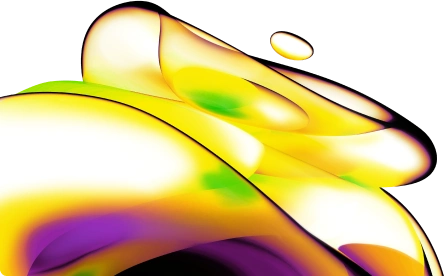

AlphaLISA SureFire Ultra Human and Mouse Total AXIN-1 Detection Kit, 500 Assay Points
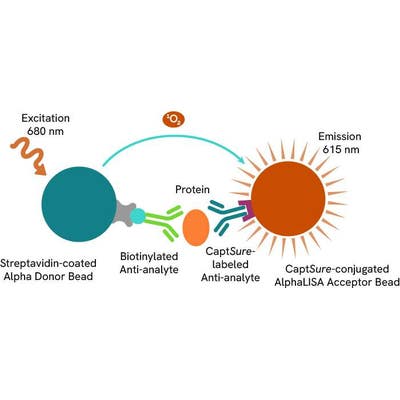

AlphaLISA SureFire Ultra Human and Mouse Total AXIN-1 Detection Kit, 500 Assay Points
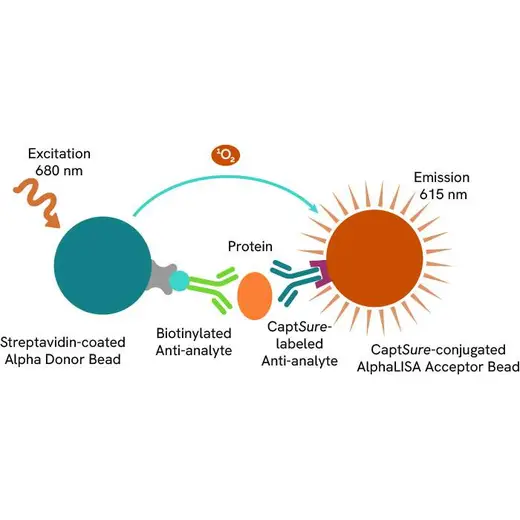


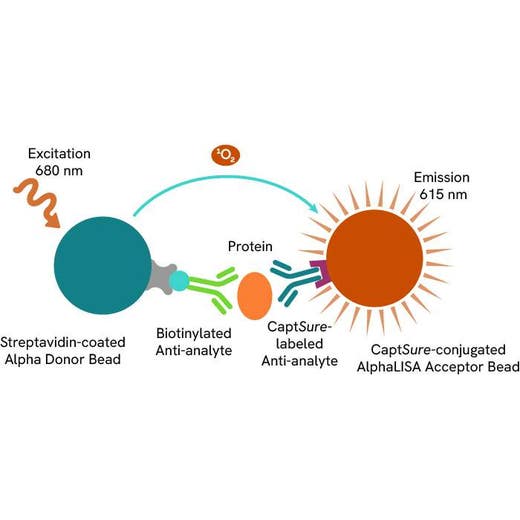


The AlphaLISA™ SureFire® Ultra™ Human and Mouse Total AXIN-1 assay is a sandwich immunoassay for quantitative detection of total AXIN-1 in cellular lysates using Alpha Technology.
| Feature | Specification |
|---|---|
| Application | Cell Signaling |
| Protocol Time | 2h at RT |
The AlphaLISA™ SureFire® Ultra™ Human and Mouse Total AXIN-1 assay is a sandwich immunoassay for quantitative detection of total AXIN-1 in cellular lysates using Alpha Technology.



AlphaLISA SureFire Ultra Human and Mouse Total AXIN-1 Detection Kit, 500 Assay Points



AlphaLISA SureFire Ultra Human and Mouse Total AXIN-1 Detection Kit, 500 Assay Points



Product information
Overview
Axis inhibition protein 1 (AXIN-1) is a scaffold protein essential for regulating the WNT/β-catenin pathway. It forms the destruction complex with APC, GSK3β, and CK1α to mediate β-catenin degradation, thereby controlling cell proliferation and differentiation. Upon activation of WNT signaling, this complex disassembles, allowing β-catenin to activate the transcription of target genes involved in cell survival and growth. Dysregulation of AXIN-1 can drive tumorigenesis and is associated with neurodegenerative diseases like Alzheimer's due to its role in maintaining cellular homeostasis.
The AlphaLISA SureFire Ultra Human and Mouse Total AXIN-1 Detection Kit is a sandwich immunoassay for the quantitative detection of total AXIN-1 in cellular lysates, using Alpha Technology.
Formats:
- The HV (high volume) kit contains reagents to run 100 wells in 96-well format, using a 60 μL reaction volume.
- The 500-point kit contains enough reagents to run 500 wells in 384-well format, using a 20 μL reaction volume.
- The 10,000-point kit contains enough reagents to run 10,000 wells in 384-well format, using a 20 μL reaction volume.
- The 50,000-point kit contains enough reagents to run 50,000 wells in 384-well format, using a 20 μL reaction volume.
AlphaLISA SureFire Ultra kits are compatible with:
- Cell and tissue lysates
- Antibody modulators
- Biotherapeutic antibodies
AlphaLISA SureFire Ultra kits can be used for:
- Cellular kinase assays
- Receptor activation studies
- High-throughput screening for preclinical studies
Specifications
| Application |
Cell Signaling
|
|---|---|
| Automation Compatible |
Yes
|
| Brand |
AlphaLISA SureFire Ultra
|
| Detection Modality |
Alpha
|
| Protocol Time |
2h at RT
|
| Shipping Conditions |
Shipped in Blue Ice
|
| Target |
AXIN-1
|
| Target Class |
Phosphoproteins
|
| Target Species |
Human
Mouse
|
| Technology |
Alpha
|
| Therapeutic Area |
Neuroscience
Oncology
|
| Unit Size |
500 assay points
|
Video gallery

AlphaLISA SureFire Ultra Human and Mouse Total AXIN-1 Detection Kit, 500 Assay Points

AlphaLISA SureFire Ultra Human and Mouse Total AXIN-1 Detection Kit, 500 Assay Points

How it works
Total-AlphaLISA SureFire Ultra assay principle
The Total-AlphaLISA SureFire Ultra assay measures the expression level of a protein target in a cell lysate.
The Total-AlphaLISA SureFire Ultra assay uses two antibodies which recognize two different distal epitopes on the targeted protein. AlphaLISA assays require two bead types: Acceptor and Donor beads. Acceptor beads are coated with a proprietary CaptSure™ agent to specifically immobilize the assay specific antibody, labeled with a CaptSure tag. Donor beads are coated with streptavidin to capture one of the detection antibodies, which is biotinylated. In the presence of targeted protein, the two antibodies bring the Donor and Acceptor beads in close proximity whereby the singlet oxygen transfers energy to excite the Acceptor bead, allowing the generation of a luminescent Alpha signal. The amount of light emission is directly proportional to the quantity of protein present in the sample.

Total-AlphaLISA SureFire Ultra two-plate assay protocol
The two-plate protocol involves culturing and treating the cells in a 96-well plate before lysis, then transferring lysates into a 384-well OptiPlate™ plate before the addition of Total-AlphaLISA SureFire Ultra detection reagents. This protocol permits the cells' viability and confluence to be monitored. In addition, lysates from a single well can be used to measure multiple targets.
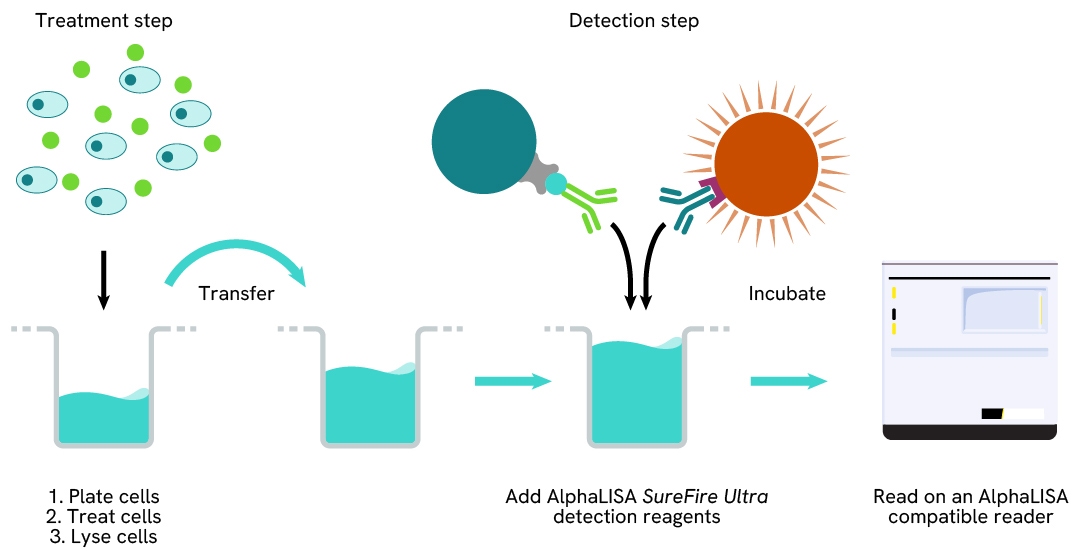
Total-AlphaLISA SureFire Ultra one-plate assay protocol
Detection of Total target protein with AlphaLISA SureFire Ultra reagents can be performed in a single plate used for culturing, treatment, and lysis. No washing steps are required. This HTS designed protocol allows for miniaturization while maintaining AlphaLISA SureFire Ultra quality.
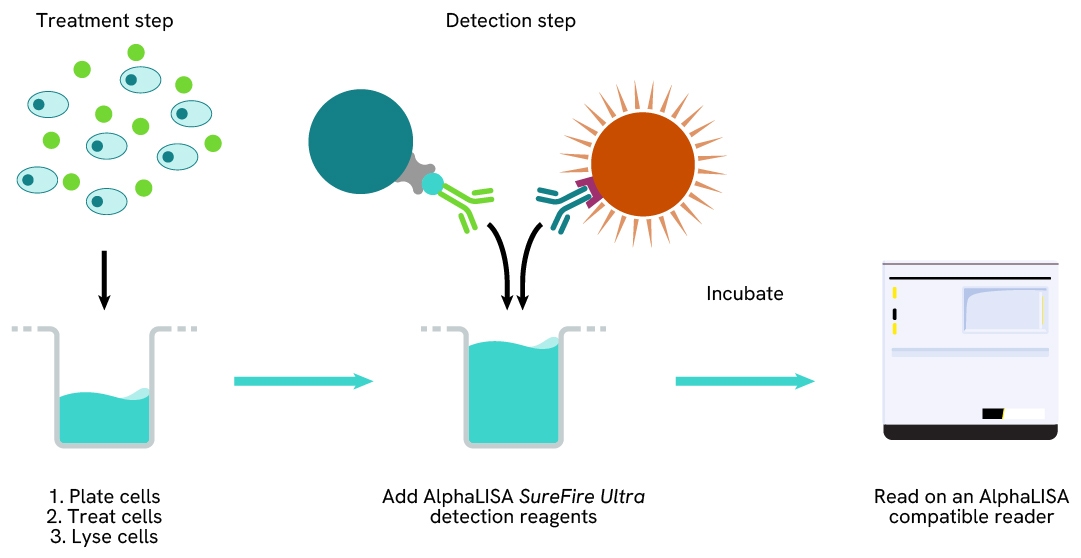
Assay validation
Increase of AXIN-1 Total levels in XAV-939 treated cells
MCF7 cells were seeded in a 96-well plate (40,000 cells/well) in complete medium, and incubated overnight at 37°C, 5% CO2. The cells were treated with increasing concentrations of a Tankyrase inhibitor (XAV-939) for 24 hours.
After treatment, the cells were lysed with 100 µL of Lysis Buffer for 10 minutes at RT with shaking (350 rpm). AXIN-1 and Cofilin Total levels were evaluated using respective AlphaLISA SureFire Ultra assays. Lysate was further diluted 1:10 in Lysis Buffer for the Cofilin assay. For the detection step, 10 µL of cell lysate (approximately 4,000 cells for AXIN-1 and 400 cells for Cofilin) was transferred into a 384-well white OptiPlate, followed by 5 µL of Acceptor mix and incubated for 1 hour at RT. Finally, 5 µL of Donor mix was then added to each well and incubated for 1 hour at RT in the dark. The plate was read on an Envision using standard AlphaLISA settings.
As expected, treatment with XAV-939 triggered a dose-dependent increase in the levels of AXIN-1 while Total Cofilin levels remain unchanged.
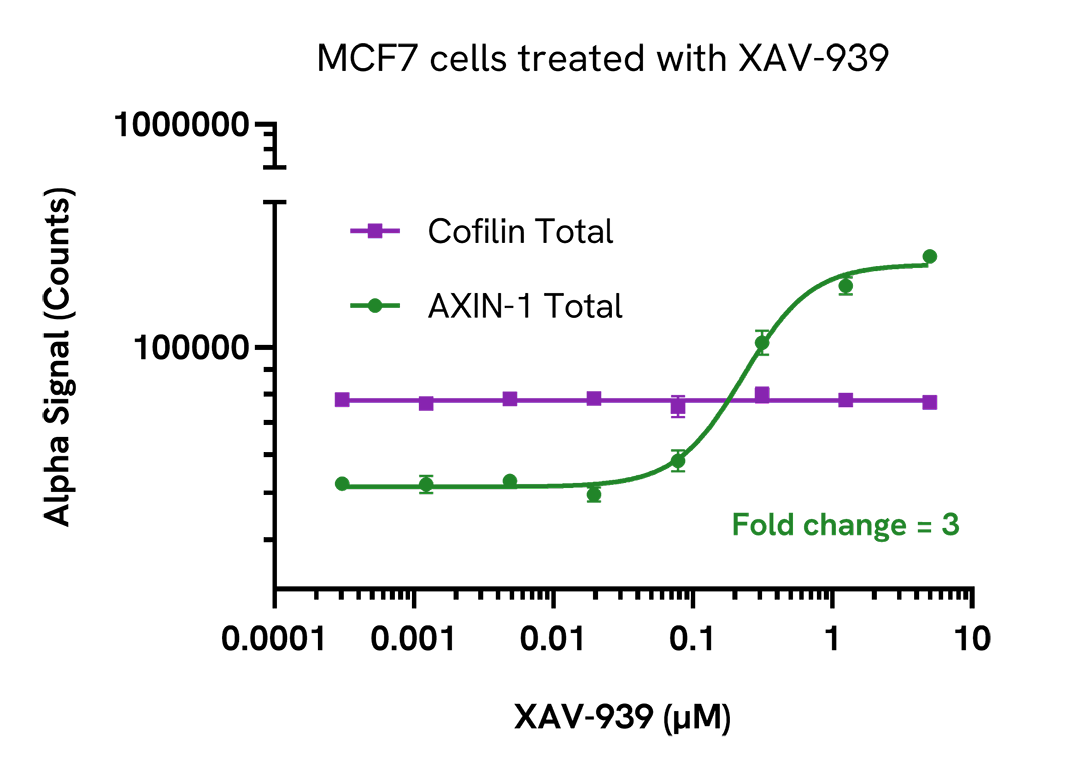
Specificity of AXIN-1 Total assay
Specificity of the Total AXIN-1 assay was assessed by assaying AXIN-1 and AXIN-2 recombinant human proteins.
Recombinant AXIN-1 (Abcam, ab204090) and AXIN-2 (Abcam, ab204097) proteins were prepared in Lysis Buffer at 500 ng/mL. AXIN-1 Total levels were evaluated using the AlphaLISA SureFire Ultra assay. For the detection step, 10 µL of protein was transferred into a 384-well white OptiPlate, followed by 5 µL of Acceptor mix and incubated for 1 hour at RT. Finally, 5 µL of Donor Mix was then added to each well and incubated for 1 hour at RT in the dark. The plate was read on an Envision using standard AlphaLISA settings.
Total AXIN-1 assay reacts only to AXIN-1 recombinant protein with no cross-reactivity observed to AXIN-2 recombinant protein. These results demonstrate the specificity of the AXIN-1 Total assay as these two proteins share approximately 50% sequence identity.
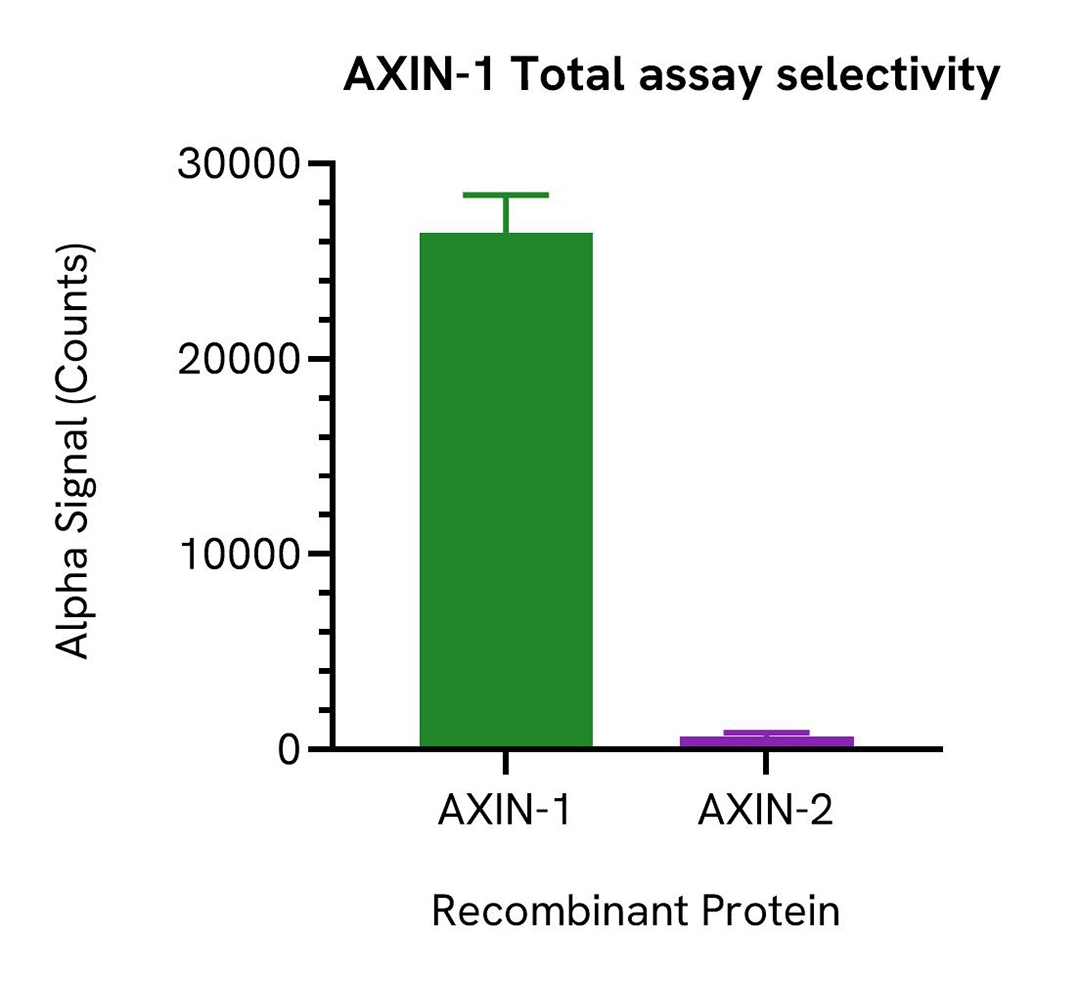
Versatility of Total AXIN-1 assay in various cell lines
Various cell lines were seeded at 40,000 cells/well in a 96-well plate in complete medium and incubated overnight at 37°C, 5% CO2. Cells were lysed with 100 µL of Lysis Buffer.
AXIN-1 Total levels were evaluated using the AlphaLISA SureFire Ultra assay. For the detection step, 10 µL of cell lysate (approximately 4,000 cells) were transferred into a 384-well white OptiPlate, followed by 5 µL of Acceptor Mix and incubated for 1 hour at RT. Finally, 5 µL of Donor Mix was then added to each well and incubated for 1 hour at RT in the dark. The plate was read on an Envision using standard AlphaLISA settings.
AXIN-1 is expressed across a wide range of human and mouse cell types. High levels of Total AXIN-1 were detected in SW 48, Hep G2 and MEF cell lines.

Resources
Are you looking for resources, click on the resource type to explore further.
The definitive guide for setting up a successful AlphaLISA SureFire Ultra assay
Several biological processes are regulated by...
Discover Alpha SureFire® Ultra™ assays, the no-wash cellular kinase assays leveraging Revvity's exclusive bead-based technology...
This document includes detailed tables listing HTRF™, AlphaLISA™ SureFire® Ultra™, and Alpha SureFire® Ultra™ Multiplex assays...
Loading...


How can we help you?
We are here to answer your questions.
